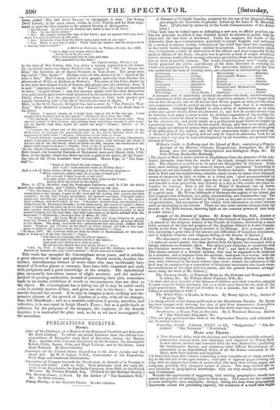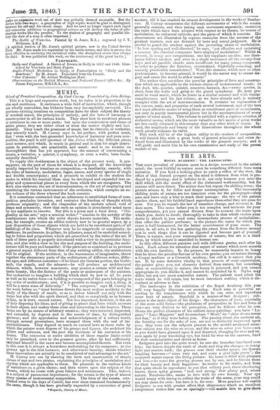PUBLICATIONS RECEIVED.
BOOKS.
Lives of the Lindsays; or a Memoir of the Houses of Crawford and Balcarres. By Lord Lindsay. To which are added, Extracts from the Official Cor- respondence of Alexander sixth Earl of Balcarres, during the Maroon War; together with Personal Narratives by his Brothers, the Honourable Robert, Colin, James, John, and Hugh Lindsay, and by his Sister, Lady Anne Barnard. In three volumes.
Narrative of the United States Expedition to the River Jordan and the Dead Sea. By W. F. Lynch, U.S.N., Commander of the Expedition. With Maps and numerous Illustrations.
Narratives of Voyages towards the North-west, in Search of a Passage to Cathay and India. 1496 to 163t. With Selections from the early Re- cords of the Honourable the East India Company, from MSS. in the British Museum. By Thomas Randall, Esq. (Printed for the Haklayt Society.) The Rectory Guest; a Novel. By the Author of " The Gambler's Wife," &c. In three volumes.
Fanny Hervey; or the Mother's Choice. In two volumes.
A Manual of Scientific Inquiry; prepared for the use of her Majesty's Navy, and adapted for Travellers in general. Edited by Sir John F. W. Herschel, Bart (Published by authority of the Lords Commissioners of the Admi:
rally.) [This book may be looked upon as indicating a new sera in official practice, aa. less the principle on which it was founded should be allowed to perish with its originator, the late Earl of Auckland. Under his auspices, the Lords of the Admiralty drew up a memorandum, positively in simple English, and animated by a rational or human feeling, indicative of the belief that there was something in the world besides bureaucracy entitled to attention. Lord Auckland's object was, to inculcate a habit of observation in the officers and more especially in ula medical officers of the Navy: his plan was to provide a book of simple directions how to observe, intelligible to average education and ability, from the fiends of mas- ters in their respective sciences. The Lords Commissioners were "readily snug kindly promised the advice and labours of Sir John Herschel in revising the whole and preparing it for publication." The particular subjects, aHnednethheeLmell who undertook the task of treating them, are contained in the following list. Meteorology ASBaei Sabine. Astronomy Magnetism Atmospheric Waves Hirt.
Owen.
Geology Geography. Whewell.
Hamilton. EBtohtaLsylogy
Zoology Medicine and Medical Sta- Hydrography pliriootchherard.
Earthquakes Darwin.
Mallet. Hales Bryson. Mineralogy De la Roche. Statistics Porter. A common fate of authorship attended the effort—the book, notwithstanding the curtailment of the manuscripts by their respective authors, is still longer than was at first designed : but we do not see how fifteen papers on subjects like those just enumerated could be packed up into less compass than that of a moderate- sized volume. Although the Manual is only a series of instructions as to what points an inquirer should direct his attention to, and how he should record what he observes, each paper is more or less an informal exposition of the leading ele- ments of the science of which it treats. The reader has the pith of the matter by the shortest cut, and pretty much as a professional pupil would be taught by a practical man. lie is told to do the easiest things, and how to do them; and, what might not always be gotten from a practical man indications are often given of the principles of the science, and the best elementary books are pointed out. A Manual of Scientific Inquiry will not only be found an admirable book for its express object, but may be used advantageously by all travellers, and perused with interest at home.] Wilson's Guide to Rothesay and the Island of Bute; containing a Popular Account of the History, Climate, Temperature Antiquities, &c. of the Island; also two accurate Geographical and Geological Maps, &c. By John Wilson, Bookseller, Rothesay. [The name of Bute is better known to Englishmen from the demerits of the cele- brated favourite, than from the merits of the island, though they are consider- able.. The climate is so mild as to be rated the Montpellier of Scotland. Little frost, snow melting quickly, fogs scarcely known, and " perennials" flourishing in the open air, are the climatic allurements for Northern invalids. Beautiful scenery both in Bute and the neighbouring counties, ready access by steam from Glasgow, means of excursion by land or water at a cheap rate, "good accommodation for man or beast," as the old English signs say or said, and a country whose length and breadth a stout pedestrian may traverse in a day or two, render the place at- tractive for tourists. Bute is the Isle of Wight of Scotland; but as heroes perish for want of a poet, it has remained comparatively unknown for want of a guide-book. Mr. Wilson, bibliopole of Rothesay the capital of the island, has
i
here supplied that deficiency, in a plain, unpretending, and businesslike way. The Guide to Rothesay and the Island of Bute gives an account of the scenery, natu- ral peculiarities,. and antiquities of the island, with informatiou on other matters quite as interesting to the tourist. There are also some curious extracts from the records of the Kirk-Session, throwing light on the censorial powers of that body in olden times.] Annals of the Diocese of Quebec. By Ernest Hawkins, B.D., Author of "Historical Notices of the Missions of the Church of England in America." [A sketch of the religions history of the French in Canada; followed by a much fuller account of the rise and progress of the Anglican Church in Lower Canada, chiefly in the form of biographical notices of its Bishops. It is a simple narra- tive, conveying a good idea of the labours and difficulties of Canadian churchmen, and of religious economy and religious feeling in the diocese of Quebec.] The Sanctuary: its Lessons and its Worship. By Mango Penton, F.R.S.E. [A series of sacred poems, the ideas derived from Scripture, but arranged with certain reference to dramatic effect. The subjects are religious, or connected with the Christian services—as " The House of God"; and each is called a Theme. This theme consists of a didactic address, that may be supposed to be delivered by a minister, and a response from the auditors, analogous to a chorus, with the occasional intermingling of a hymn. The ideas are drawn directly from Scrip- ture, with references to the texts whence they come: indeed, the substance of the book may be considered as a translation of Scriptural sentiments into blank verse; the combination of the ideas into one theme, and the general dramatic arrange- ment, being the work of Mr. Penton.]
The Nursery Guide; or Practical Hints on the Diseases and Management of Children, &c. By William Home Popham, M.B., &c.
[A short and clear account of the diseases of children and their remedies, adapted in some cases for family guidance, but as a whole more fitted for the desk of the pupil-practitioner. We know not whether it is a mistake, but the date of the talepage and preface is 1847.]
The Witch Wife; a Drama, in five acts. By Henry Spicer, Esq., Author of " Honesty," &c.
[A cheap edition of the drama performed at the Marylebone Theatre. Mr. Spicer has been charged with deriving the idea of plot from Ainsworth's Lancashire Witches; but he states in his preface that he has never read that romance.] Strathmore; a Tragic Play, in five acts. By J. Westland Marston, Author of " The Patrician's Daughter," &e. [The new play performed this week at the Haymarket Theatre, and criticised in our theatrical notices.] Waverley Novels. Volumes X-XXV. to XL. " Bodgauntlet." "The Be- trothed." " The Talisman." " Woodstock."
MAPS AND PRINTS.
A New General Atlas, with the divisions and boundaries carefully coloured;
constructed entirely from new drawings, and engraved by Sidney Hall. A new edition, revised and corrected from the best Authorities, (including the Government Survey, and numerous other Official Documents); ac- companied by an Alphabetical Index of all the Names contained in the Maps, with their latitude and longitude. [A handsome large folio volume, containing a very complete set of maps, extend- ing to the full size of the open volume ; each pair of opposite pages farming one map, with an alphabetical index of names that fills more than twenty pages, and comprises probably fifty thousand names of places. The maps include the re- cent additions to geographical knowledge; they are very clearly executed, and easy of reference. We take the opportunity of suggesting, that sterling geographers should now amend the practice of omitting dates to their maps. The reason for the omission is more intelligible than creditable; though, during the time when geographical. discoveries outran the publishing capacity, the avoidance of a mark that isught make an expensive work out of date was probably deemed excusable. But the device tells two-ways: a geographer of high repute would be glad to distinguish between his old and his recent maps. And we need no longer expect such rapid and extensive additions to geographical science as will destroy the value of sub- stantial works like the present. To the student of geography and parallel his- tory the date of a map is often important.]
The Battle of Waterloo. Painted by G. Jones, 11.A.; engraved by J. T. Willmore, A.B.A. IA spirited version of Mr. Jones's spirited picture, now in the United Service blab. Mr. Jones made his reputation by his battle-soenes, and this is among the most effective in rendering the turbulent order, the disciplined storm that sweeps the field. It was published this week, on the anniversary of the great battle.]
PAMPHLETS.
Sicily and England. A Sketch of Events in Sicily in 1812 and 1848. Illus- trated by Vouchers and State Papers.
Anglo-French Mediation in Sicily; or Postscriptum to "Sicily and the Bourbons." By Id. Amari. Translated from the French.
" Our Colonies." By Arthur Wellington Hart. Observations on the British Museum, and National Record Office, &c. By James Fergnsson, M.R.I.B.A., &c.



























 Previous page
Previous page